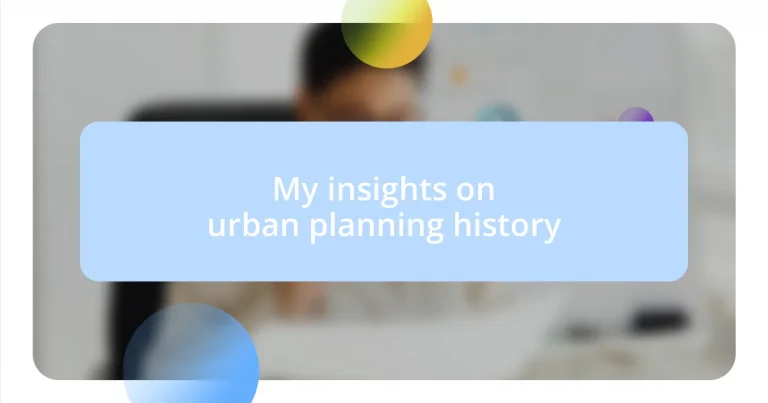Key takeaways:
- The Industrial Revolution prompted rapid urbanization, necessitating systematic urban planning to address overcrowding and infrastructure demands.
- The rise of Modernism in the 20th century aimed to combine urban design with societal well-being, responding to issues like urban poverty.
- Innovative case studies, such as Copenhagen’s cycling infrastructure and Medellín’s cable cars, showcase successful urban planning strategies that enhance accessibility and community engagement.
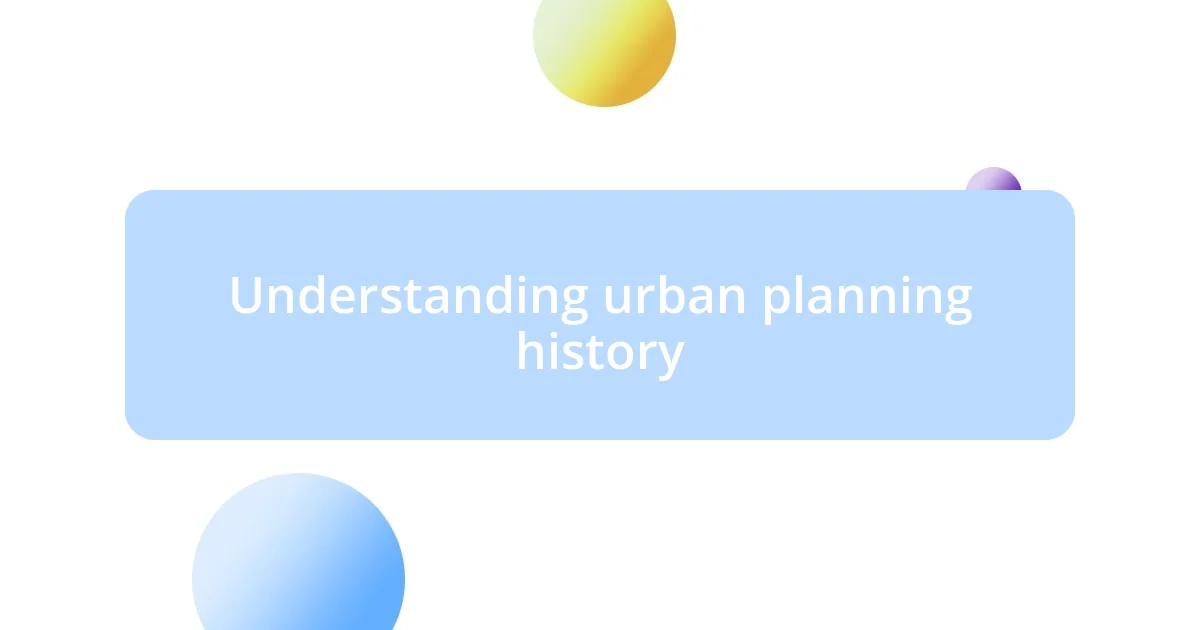
Understanding urban planning history
Urban planning history offers us a fascinating lens to examine how cities have evolved. I often find myself reflecting on the layers of development that shape our urban spaces today. Have you ever walked through a city and felt echoes of its past in the architecture or layout? That sense of historical continuity can be both inspiring and sobering.
When I first delved into urban planning, I was struck by the contrasts between different eras. From the grid systems of ancient Rome to the sprawling suburbs of the 20th century, each period reflects its societal values and challenges. It’s incredible to think about how planning decisions, often made years ago, influence our daily lives, isn’t it?
One of the most compelling aspects of urban planning history is how it can reveal prevailing social dynamics. For instance, the rise of Modernist principles in the mid-20th century wasn’t just about aesthetics; it was an attempt to address urban poverty and overcrowding. As I learned about these intentions, I began to appreciate the deep relationship between urban design and community well-being, which continues to evolve in today’s planning conversations.
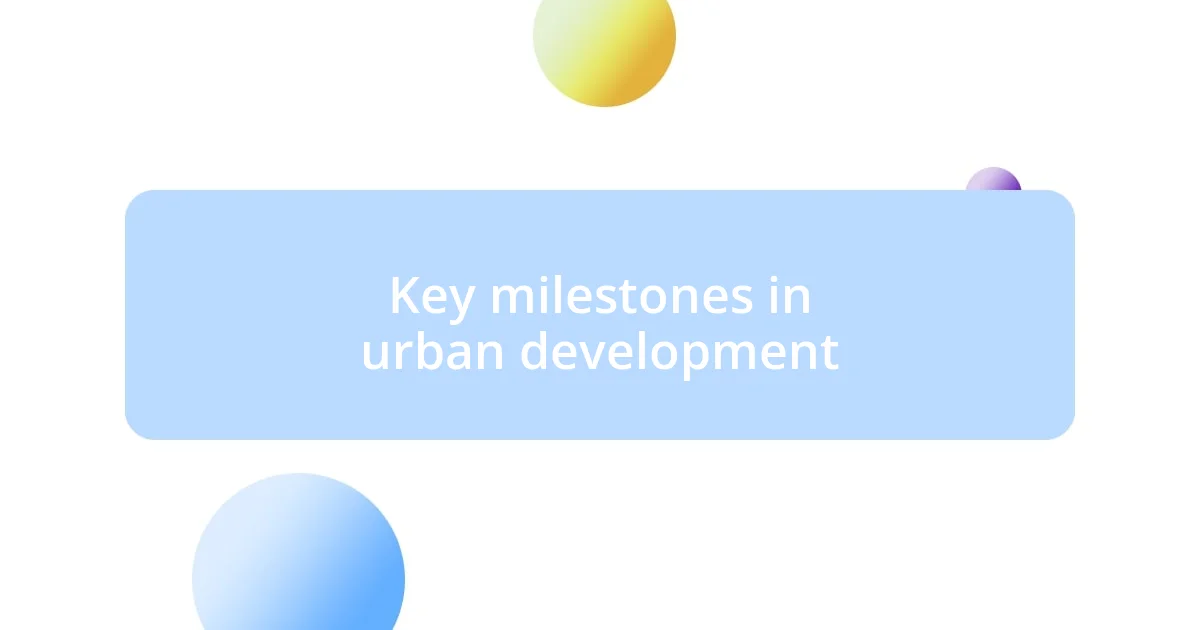
Key milestones in urban development
Key milestones in urban development reveal the evolution of our cities, reflecting societal changes and innovative thinking. One moment that stands out in my mind is the impact of the Industrial Revolution. During this period, cities grew at an unprecedented pace, drawing people from rural areas seeking work. It was remarkable to witness, through my studies and explorations, how this surge led to the development of infrastructure like railways and roads, which are still essential today.
Here are some pivotal milestones in urban development:
- Ancient Civilizations: The establishment of grid systems in cities like Babylon set early foundations for urban planning.
- The Renaissance: This era redefined public spaces, emphasizing aesthetics and the importance of cultural heritage.
- The Industrial Revolution (18th-19th centuries): Rapid urbanization created challenges and prompted the need for systematic planning.
- The Garden City Movement (late 19th century): This concept introduced the idea of green spaces within urban settings, promoting healthier living conditions.
- Modernism and Le Corbusier (20th century): This movement revolutionized city design, advocating for functionality and light-filled spaces.
- Smart Growth and New Urbanism (late 20th century): These approaches focus on sustainable development and community-oriented spaces, a shift that resonates with me as I consider the future of our cities.
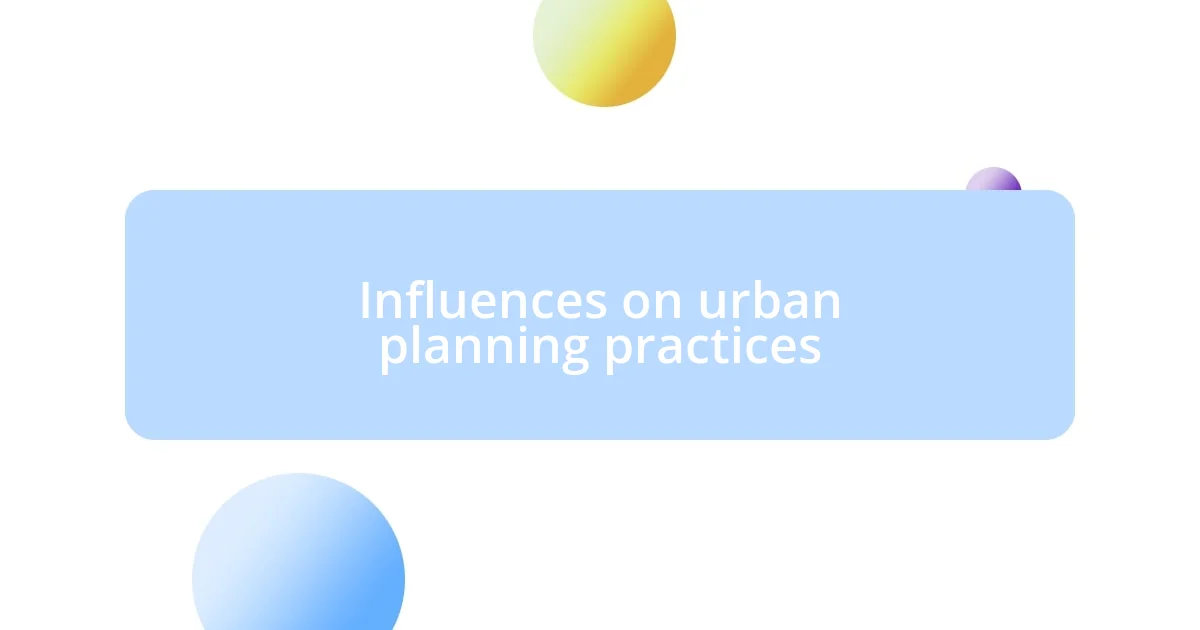
Influences on urban planning practices
Urban planning practices are shaped by a multitude of influences, each telling a different story about our social values and needs. One can trace these influences from early models of community organization, where natural landscapes dictated settlement patterns, to the complex needs of contemporary metropolis that prioritize sustainability and liveability. I often think back to my own experiences in various cities—some felt welcoming and vibrant, while others seemed disconnected and chaotic, which made me appreciate the underlying planning philosophies that enabled those varied atmospheres.
The technological advancements we see today cannot be ignored in their role in shaping urban planning. From the advent of the automobile, which transformed city layouts into sprawling configurations, to the recent rise of digital tools that facilitate smart city planning, technology has continuously redefined how we understand and engage with urban spaces. I remember a visit to a city that embraced high-tech infrastructure. Walking through its streets, I was struck by how seamlessly technology integrated into daily life, enhancing both efficiency and quality of life.
Cultural shifts also play a pivotal role in urban planning. As societies evolve, so too do their priorities and challenges. The increasing awareness of climate change and social inequality has led to a re-evaluation of urban strategies. We’re witnessing shifts towards more equitable planning practices that center on community engagement. This resonates with my personal belief that urban spaces should reflect the voices of those who inhabit them. Have you ever felt that a neighborhood truly represents its community? That’s the kind of planning I hope to see more of in the future.
| Influence | Description |
|---|---|
| Historical Context | Shapes urban layouts based on societal values. |
| Technology | Transforms how cities function and evolve. |
| Cultural Shifts | Reflects priorities leading to equitable planning. |
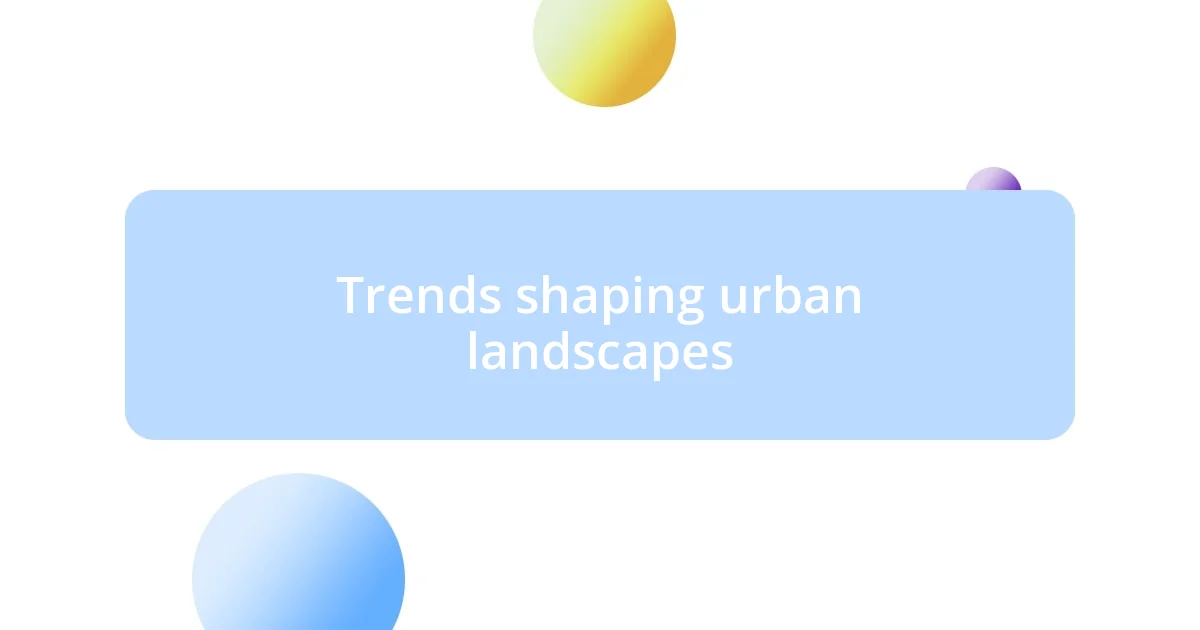
Trends shaping urban landscapes
Urban landscapes are continually evolving, influenced by various trends that reflect our changing lifestyles and values. One notable trend is the emphasis on sustainability. I recall walking through a city where lush green rooftops and solar panels adorned buildings. It felt like a breath of fresh air, literally! The integration of nature into urban spaces not only beautifies cities but also combats pollution and enhances residents’ well-being. Isn’t it amazing how cities can breathe with the inclusion of greenery?
Another significant movement shaping urban landscapes is the push for mixed-use developments. I remember visiting a neighborhood where shops, restaurants, and residences all coexisted, making it possible for people to live, work, and play within a short stroll. This design fosters community interaction and reduces reliance on cars. Who wouldn’t appreciate a place where everything you need is just a few steps away? It truly transforms the daily experience of living in a city.
Lastly, smart city innovations are redefining how urban areas function. The other day, I was in a smartly designed neighborhood where everything from streetlights to waste management was interconnected through technology. It was intriguing to see how data-driven solutions were streamlining city operations, resulting in greater efficiency. As I wandered through those tech-enabled streets, I couldn’t help but wonder: what could our cities look like if we continue to embrace such innovations? The potential for a harmonious urban experience is right before us.
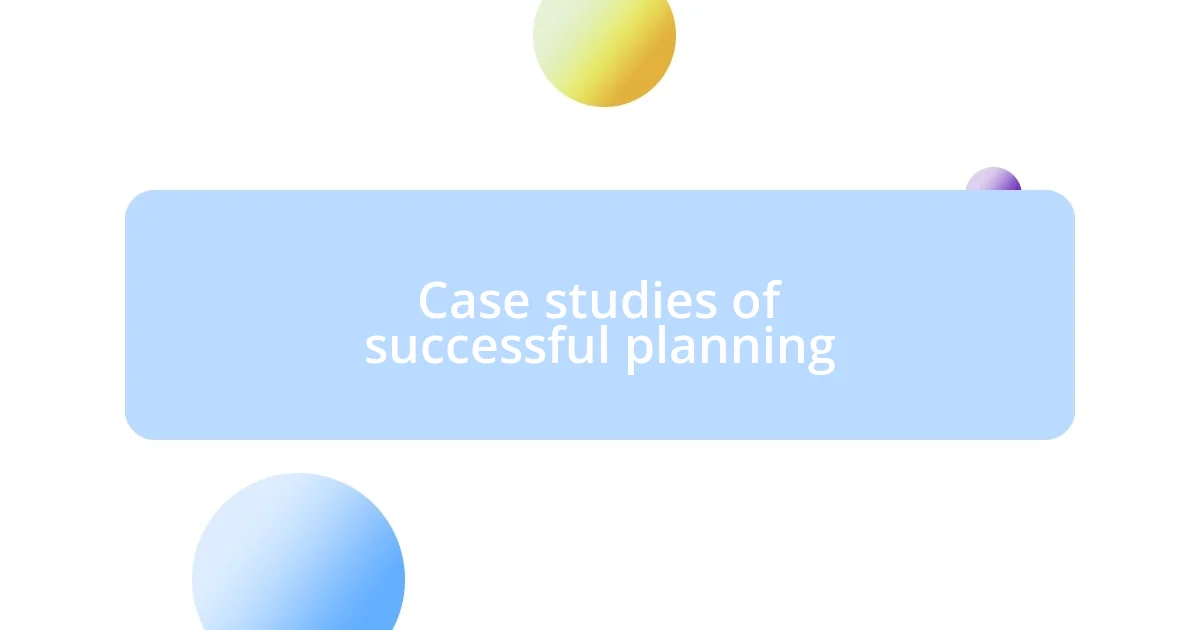
Case studies of successful planning
One striking example of successful urban planning comes from Copenhagen, where the city has embraced cycling as a primary mode of transportation. On my visit to this vibrant city, I was amazed by the extensive bike lanes and the number of cyclists sharing the roads. It felt invigorating! This intentional design not only reduced traffic congestion but also fostered a strong sense of community. Don’t you think that promoting healthier lifestyles through thoughtful infrastructure is a win-win?
Another compelling case is the transformation of Medellín, Colombia. I had the opportunity to explore the innovative use of cable cars that connect hillside communities to the city center. It was a profound experience to witness how this solution provided accessibility to those who had long been marginalized. It made me reflect: wouldn’t it be exciting if other cities adopted similar ideas to break down barriers and promote inclusivity?
Lastly, I can’t help but mention Barcelona’s superblocks initiative, which aims to limit traffic in certain areas to prioritize pedestrian movement and green spaces. Walking through one of these zones, I felt an overwhelming sense of peace. There were families enjoying picnics, street performers, and children playing without the constant worry of cars. Isn’t that the kind of urban environment we all desire? Cities like Barcelona are showing us the power of reimagining our spaces for people, and I find that incredibly inspiring.
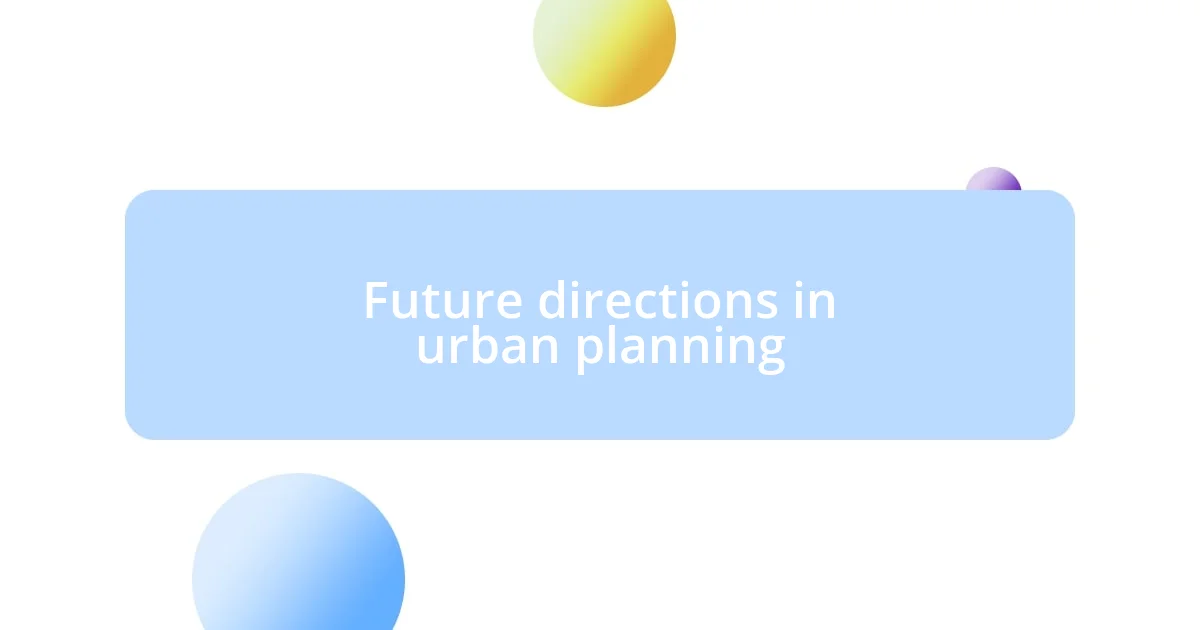
Future directions in urban planning
As I think about the future of urban planning, the integration of technology into our daily lives stands out as a significant direction. Imagine walking down a street where sensors detect foot traffic and adjust street lighting accordingly, creating a safer environment without wasting energy. I’ve seen glimpses of this at innovative urban tech expos, and it sparks excitement in me—what if we could live in cities that adapt to our needs in real-time?
Zero-energy buildings are another path that captivates my imagination. I was recently in a workshop focused on passive design principles, and I learned how these buildings can produce as much energy as they consume. Just picturing a skyline filled with structures designed to harness natural light and wind makes my heart race. Could this be the key to not just reducing our carbon footprint, but also to creating a lifestyle that feels seamlessly connected to the environment?
There’s also an increasing focus on community-driven planning. I remember volunteering at a local town hall meeting, where residents passionately discussed their visions for public spaces. It reminded me how crucial it is for urban planners to engage with the community. If we truly want to build cities that reflect the needs of their inhabitants, wouldn’t it be transformative to have every voice heard? I believe that real progress lies in collaboration—where innovation meets the fabric of real life.
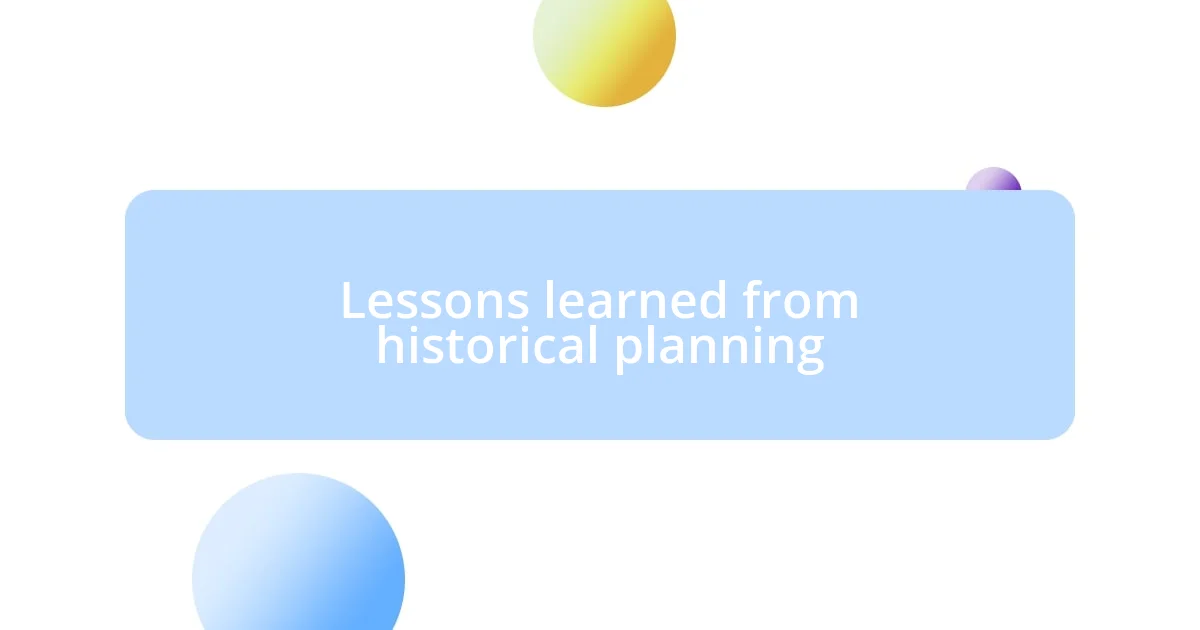
Lessons learned from historical planning
Reflecting on historical planning teaches us invaluable lessons about the importance of inclusivity. During my studies, I discovered how the revitalization of New York’s High Line not only transformed an abandoned railway into a vibrant green space but also highlighted the need for urban revitalization to include voices from all community stakeholders. Isn’t it fascinating how a simple idea can evolve into a cherished public space that fosters connection?
One striking lesson from history is the significance of adaptability in urban design. Take for example the early planning efforts in Boston, where the city’s organic growth and twisty streets became a glorious tapestry of charm. I realized that sometimes, rigid adherence to a master plan can hinder a city’s organic development. Don’t you think flexibility could be key to creating eclectic, engaging urban environments that reflect the unique personality of their inhabitants?
Lastly, we’ve seen how poor planning can lead to environmental consequences. The struggles of cities like Detroit, where urban decay stemmed from unchecked suburban expansion, resonate with me. I often wonder—what if those decisions had prioritized sustainable development from the start? Historical shortcomings remind us that mindful planning is essential in preserving not just the character of our cities but also the health of our planet.












